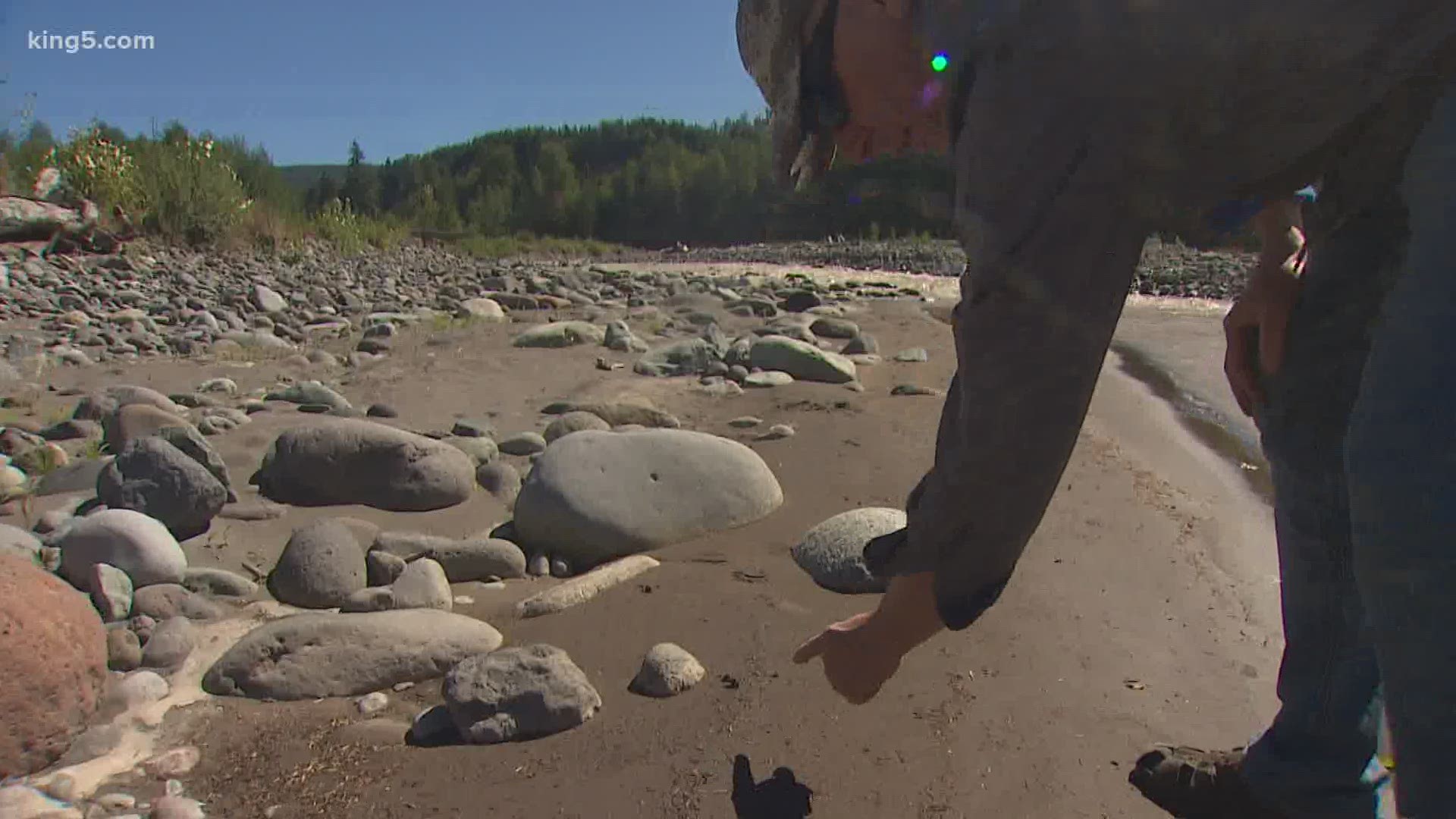ORTING, Wash. — Regulators are working on a remediation plan for the Puyallup River, after a dam construction project released an unknown number of small rubber particles into the waterway.
The century-old Electron Dam, which is being modernized, sits several miles upriver from the town of Orting, outside the boundary of Mt. Rainier National park, where the Puyallup River begins. It diverts water into a flume, which is channeled to power 20,000 homes.
Tollhouse Energy Company, of Bellingham, said at the end of July, “a synthetic turf material was used underneath the primary HDPE heavy plastic seal as a protective cushion” in a channel to divert water away from the project while crews were working.
But during high flow, the sheeting ripped, sending an estimated 617 square yards of the artificial turf into the river, along with an estimated 4 to 6 cubic yards of crumb rubber, according to a consultant’s report to Tollhouse in August. The particles vary in size, many about a millimeter.
"Due to its high mobility, that material is likely to be widely distributed over 40 miles of the Puyallup River," according to a report for Electron Hydro.
2,409 square yards of turf material were installed initially, according to the report, and 1,792 remain after the rupture.
The Puyallup tribe, which has treaty rights on the river, learned of the rubber release from a video posted on social media.
Tribe members raced to the dam to examine the river — and found accumulations of the crumb rubber on the riverbanks miles downstream.
Deposits were still visible Sept. 1 when Russell Ladley, the tribe’s Director of Fisheries, took KING 5 to the river for a visit.
“You can see these lines in the sand from different flow events on the beaches,” he said. “So it’s continuing to ride downstream.”
Both the Army Corps of Engineers and the Washington Department of Ecology, which issued permits for the project, said they were not informed turf would be used. Both agencies said they were not notified immediately after the rubber was released into the waterway, as is required.
“This is one of the reasons you run stuff by the regulator,” said Larry Altose, with the Department of Ecology. “I don’t think anyone would have said that’s fine.”
The agencies also said they were not informed of the use of rubber turf.
"This is not an appropriate type of material to build an in-water structure like that," a spokesperson with the Corps of Engineers told KING 5.
The project has been issued a stop-work order by the Corps of Engineers until the turf issue has been resolved. Some maintenance is allowed, but under that plan, the project managers must submit a plan for remediation.
A Tollhouse Energy spokesperson said the company is cooperating.
“The project is cooperating with the resource agencies to restart and provide material recovery and impact restoration as directed, said Tollhouse Energy director for regulatory and environmental affairs Chris Spens in a statement. “The project will continue when the issues are satisfied.”
But concerns remain for regulators and the Puyallup Tribe. Fall chinook salmon are returning to the river, and it’s unclear how the rubber might impact them.
Ladley said he’s not as worried for the adult fish, but young fish that spend years growing and feeding in the stream and tributes could view the rubber debris as prey, and it could cause a variety of problems for their health.
Salmon play an important cultural and historical role for northwest tribes like the Puyallup.
Ladley was at a loss why turf would be used for such an application.
“It’s heartbreaking,” he said. “We’re doing everything we can to help salmon, improve their runs, their habitat. And this is something that’s so avoidable. So easily avoidable. That’s the real tragedy, I feel.”
Consultants for Tollhouse Energy concluded the rubber is "not expected to cause severe harm or mortality to fish."
However, Ladley is not so sure.
He said he hopes to see enforcement action and consequences as a result of this release. The Department of Ecology said Tuesday it’s focused on working with the company to mitigate the impact of the release, and multiple agencies involved have penalty authority.
Though mitigation is underway, a plan is still being developed on how to remove the remaining turf without releasing more rubber, as well as removing as many existing rubber particles as possible from the river.

